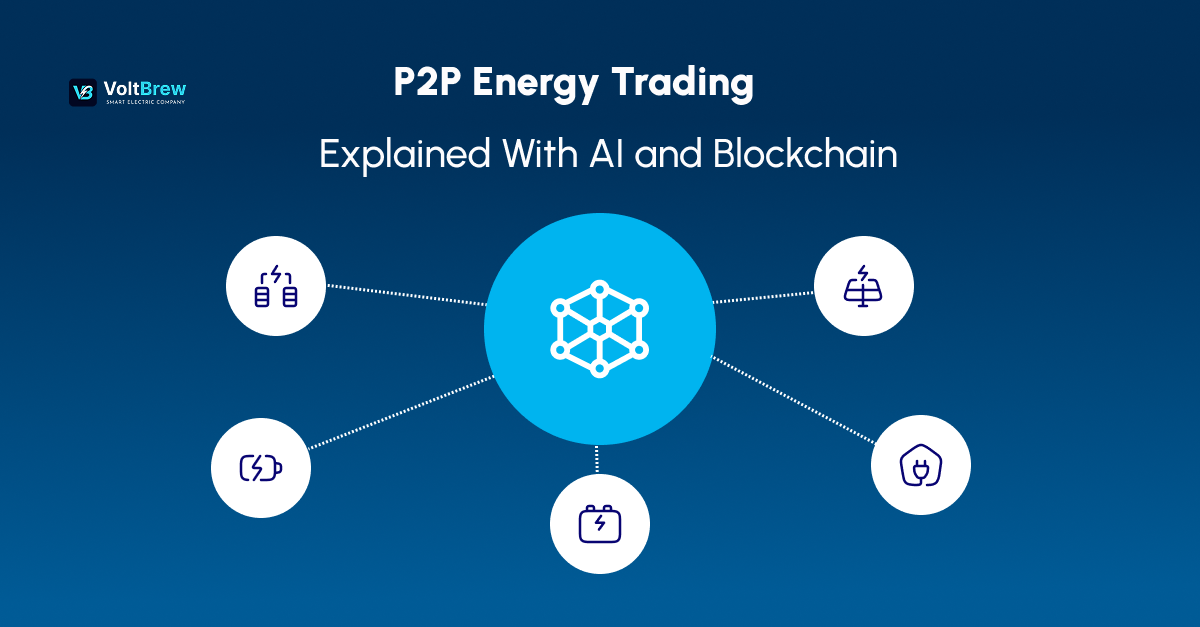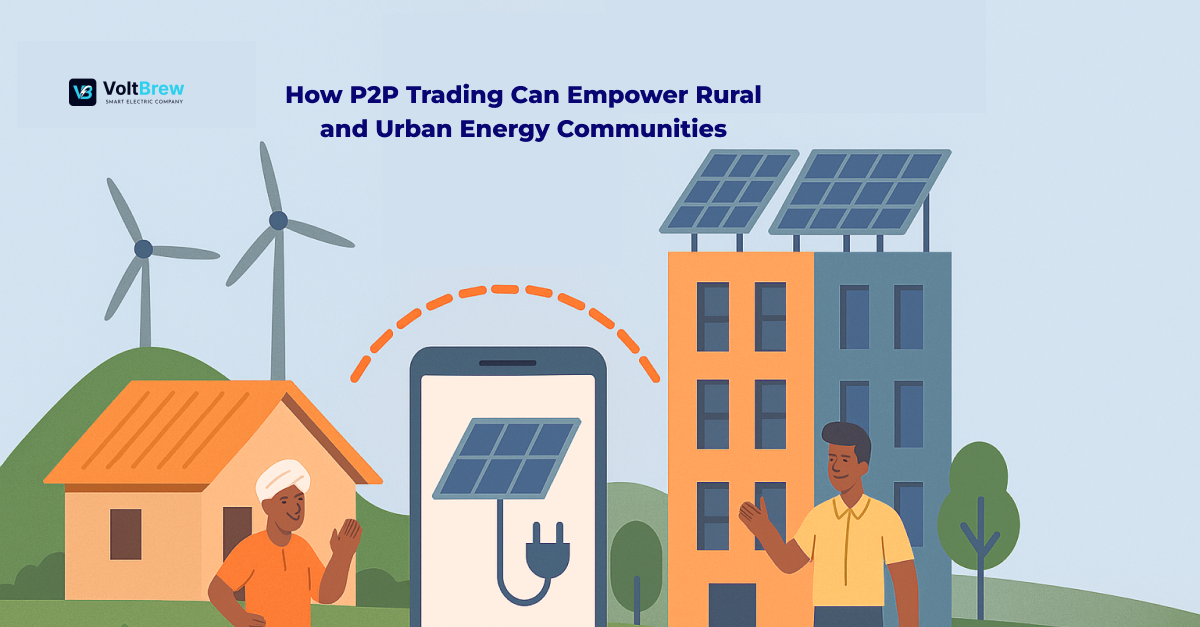P2P energy trading, AI in energy management, and blockchain energy platforms are transforming the global energy sector. As the adoption of distributed energy resources (DERs) such as rooftop solar and energy storage continues to grow rapidly, and as consumer demand shifts toward sustainability and autonomy, the limitations of traditional centralized power grids are becoming more apparent. In this context, decentralized energy systems offer a smarter, more resilient way for prosumers to generate, trade, and consume electricity with greater efficiency and transparency.
The global energy sector is undergoing a major transformation driven by the rapid adoption of distributed energy resources (DERs), such as rooftop solar and energy storage systems. As consumer preferences shift toward sustainability and energy autonomy, the inefficiencies of traditional centralized power grids are becoming increasingly evident. In response, Peer-to-Peer (P2P) energy trading is emerging as a revolutionary model within decentralized energy systems. Powered by AI in energy management and blockchain energy platforms, this approach enables prosumers to participate in a smart, secure, and transparent way to generate, trade, and consume electricity locally.
This blog explains the working of P2P energy trading systems, the role of enabling technologies like AI and blockchain, key business benefits, and how organizations can adopt this model for a resilient and efficient energy future.
Limitations of Centralized Energy Systems
Centralized power grids have served as the foundation of modern electricity distribution for over a century. However, the rise of local energy generation and smart grid technologies is exposing the fragility and inefficiencies of the traditional model. Some of the critical limitations include:
- Grid Congestion: As more consumers install rooftop solar systems and electric vehicle (EV) chargers, balancing the load across the grid has become increasingly complex.
- Low Resilience: Centralized grids are more vulnerable to outages caused by extreme weather, equipment failure, or cyberattacks.
- High Operational Costs: Energy losses in transmission, grid maintenance, and balancing supply and demand contribute to increased costs for utilities and consumers.
As the energy landscape evolves, there’s a clear need for decentralized energy systems that can adapt to real-time changes and empower end-users to participate actively in the energy market.
What is Peer-to-Peer (P2P) Energy Trading?
P2P energy trading allows individuals, communities, and organizations to generate electricity and sell the surplus directly to nearby consumers without relying on centralized utilities. Participants, known as energy prosumers, trade power via blockchain-enabled platforms that record transactions securely and transparently.
By integrating AI in smart grids, the system can manage demand, forecast generation, and optimize usage patterns, making P2P energy exchanges not only possible but highly efficient.
Core Models of P2P Energy Trading
There are three primary configurations for implementing P2P energy trading, each suited to different infrastructure and community needs:
1. Over-the-Grid Trading
This model operates within the existing centralized grid. Participants are still connected to the main grid but use P2P platforms to trade energy locally.
Key Benefits:
- Avoids intermediary costs and retail markups
- Utilizes local renewable energy sources
- Leverages AI-powered energy management to optimize consumption
2. Partly-Independent Microgrids
Semi-autonomous systems that are capable of operating independently but connect to the grid as needed.
Key Benefits:
- Reduced transmission costs and fees (savings of up to 60–70%)
- Greater control over energy flow and reliability
- Advanced energy storage and distribution using AI-based load forecasting
3. Fully-Independent Microgrids
Completely self-sustaining systems that do not rely on the main grid. These are ideal for remote, rural, or disaster-prone areas.
Key Benefits:
- Full energy autonomy and security
- High return on investment over time
- Reliability in areas with frequent outages
The Role of AI in Decentralized Energy Management
Artificial Intelligence in energy systems brings real-time intelligence to P2P energy trading through:
- Energy demand forecasting AI: Predicts future consumption patterns and generation levels
- Real-time dynamic pricing: Adjusts electricity prices based on current supply-demand ratios
- Smart load balancing: Optimizes power distribution for efficiency and cost savings
AI helps make decentralized systems smarter and more adaptive, ensuring seamless energy transactions and better decision-making.
The Role of Blockchain in Energy Trading
Blockchain technology in energy trading ensures transparency, security, and automation through features such as:
- Immutable transaction logs: Every transaction is permanently recorded, preventing fraud or disputes
- Smart contracts: Automatically execute energy trades when conditions are met
- Decentralized governance: Enables peer oversight and eliminates central authority dependency
These characteristics make blockchain a foundational pillar in the evolution of secure and scalable energy trading platforms.
Business Value of P2P Energy Trading
Embracing blockchain-based energy solutions and AI in renewable energy trading offers significant commercial and strategic advantages:

Example: The Port of San Diego implemented a hybrid microgrid and reduced its electricity costs by up to 50%, while improving resilience and environmental performance.
Environmental Impact Metrics
P2P energy systems offer measurable environmental benefits:
- Carbon Emission Reduction: Local consumption of renewables can cut CO₂ emissions by up to 30% per household annually.
- Reduced Transmission Losses: Traditional grids lose about 8% of electricity during transmission. Localized use dramatically reduces this.
- Supports Global Goals: P2P trading aligns with UN SDG7 (Affordable and Clean Energy) and SDG13 (Climate Action).
- Less Dependence on Fossil Fuels: Microgrids increase clean energy penetration, reducing reliance on coal or gas-powered plants.
Role of IoT and Smart Devices
IoT and smart devices are foundational to the success of P2P energy ecosystems:
- Real-Time Energy Monitoring: Smart meters and IoT sensors provide instant data on energy flows, generation, and usage.
- Automated Load Balancing: AI, working with IoT inputs, dynamically shifts loads and prevents overloading or outages.
- Grid Stability: Edge devices like smart inverters and energy routers facilitate seamless grid integration and local decision-making.
- User Dashboards: Provide insights into usage patterns, carbon savings, and trading performance, boosting user engagement and system efficiency.
Key Challenges in AI-Driven P2P Energy
While promising, AI-driven energy systems and blockchain energy platforms face some implementation challenges:
- Grid Integration: Aligning P2P models with existing grid regulations and infrastructure
- Regulatory Compliance: Navigating national and regional energy policies
- Cybersecurity: Protecting AI and IoT-powered systems from data breaches and cyberattacks
- Capital Costs: High upfront investment in technology and integration
Despite these challenges, the decreasing cost of smart meters, energy storage, and AI applications in energy is making these barriers more manageable.
Case Studies and Real-World Examples
Brooklyn Microgrid (USA) One of the most cited examples of P2P energy trading, the Brooklyn Microgrid leverages blockchain technology to allow residents to generate, sell, and buy solar energy within their neighborhood. Initiated by LO3 Energy, this pilot project showcases the potential of decentralized grids to build community resilience and local energy independence.
Power Ledger (Australia) Power Ledger has developed a blockchain-based platform that enables energy trading in real-time between consumers and producers. It has been implemented across various regions, including Australia, India, and Southeast Asia. The platform supports not just P2P energy transactions but also carbon credit trading and renewable energy certificate tracking.
EDF Energy (UK) EDF has piloted AI-integrated P2P trading initiatives in residential communities in the UK. These trials explore how dynamic pricing and real-time data analytics can improve household energy management and reduce grid dependency. The project emphasizes consumer empowerment and renewable energy adoption.
Detailed Regulatory Landscape
Regional Energy Law Considerations
- EU: The Clean Energy for All Europeans package supports local energy communities and mandates member states to enable consumer participation in energy markets.
- USA: Regulatory frameworks vary by state. Some, like California and New York, have introduced pilot projects and supportive policies for microgrids and P2P trading.
- India: The Indian Ministry of Power is actively exploring blockchain-based energy markets, and states like Uttar Pradesh and Delhi have begun initial regulatory consultations.
Regulator Roles
Energy regulators are crucial in licensing microgrids, approving smart meter deployments, and ensuring grid compatibility. They also enforce cybersecurity norms and tariff structures for decentralized transactions.
Future Policy Trends
Expect increased support for:
- Virtual Power Plants (VPPs)
- Smart meter subsidies
- Carbon trading integration
- Decentralized Renewable Energy (DRE) policies
- Public-private partnerships in energy tech innovation
How VoltBrew is Driving Decentralized Energy Innovation
At VoltBrew, we specialize in designing and deploying intelligent, secure, and scalable P2P energy trading solutions. Our capabilities include:
- Custom blockchain energy platforms for secure peer-to-peer transactions
- AI-powered demand forecasting and consumption analytics
- Real-time energy dashboards with pricing intelligence and carbon tracking
We empower smart communities, industrial clusters, and energy service providers to transition from traditional models to intelligent, AI and blockchain-enabled energy ecosystems.
Technology Architecture Diagram (Textual Description)
A typical P2P Energy Trading Architecture includes:
- Prosumers: Households or businesses with solar panels or other generation systems.
- Smart Meters: Devices installed at each node to monitor energy production and consumption in real-time.
- IoT Sensors: Monitor grid health, environmental data, and equipment status.
- AI Layer: Processes big data to optimize supply-demand, forecast energy generation, and suggest pricing strategies.
- Blockchain Layer: Facilitates secure, transparent transactions and enforces rules via smart contracts.
- Grid/Microgrid Interface: Ensures energy flow between the P2P system and the main grid when necessary.
Comparison Table: Centralized vs Decentralized Grids

Conclusion: The Future of Energy is Peer-Driven
P2P energy trading represents a fundamental shift from centralized control to community empowerment. With the advancement of AI in energy analytics and blockchain-based renewable energy trading, the future is no longer a centralized grid—it’s a decentralized, intelligent network of empowered prosumers.
This transformation isn’t theoretical—it’s already unfolding. The real question is: Will you lead or lag behind in the energy revolution?
Now is the time to invest in smarter, cleaner, and decentralized energy solutions.



